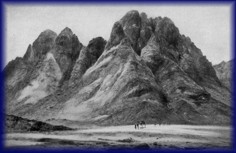 |
The case of the strange Midianite connection |
 |
|
EMMANUEL ANATI PROVIDES AN INTERESTING TWIST to the "Midianite connection". He actually accepts a Midianite location for Mount Sinai but takes it in a far-fetched direction. Here is his key argument: One of the main pieces of data emerging is that Mount Sinai. must be situated in the Midianite territory, near the borders between Midian and Amalek (Ex. 17, 9-20). The Bible further indicates that the Amalekites occupied the highlands of the Central Negev and the zone of Kadesh-Barnea , while the Midianites were located on both sides of the Aravà Valley (Anati, 1997). Mount Sinai, according to the biblical narration, is located between these two regions. Therefore, following the topographical indications, Mount Sinai is located in the area of Har Karkom. This could have been established even if nothing had been found at Har Karkom.1 His reasoning appears to depend on putting together a couple of syllogisms. The first syllogism seems to go something like this:
The next syllogism must go like this:
Even though the reasoning is reasonably sound in itw own right, the conclusion of the first syllogism is not entirely logical unless you assume a hidden premise: the attack against Israel must have taken place in Amalekite territory. This assumption cannot be sustained. First, based on the principle that God did not choose to take the Israelites out of Egypt via the Philistine Road "lest they see war and return to Egypt" (Ex. 13:17), it would have been a foolish act on God's part to lead the Israelites right into the territory of those who hated them with a passion! Furthermore, no law of the universe would have prevented the Amalekites from striking outside their own territory, particularly when you realize that extensive areas of land in those days remained unclaimed, or at least undefended. Rephidim was probably one such area. With respect to the second syllogism, the premises are wanting: • While Numbers 13:29 does say that the Amalekites lived in the "land of the south", known as the Negev, it must be remembered that this verse is describing the main concentration of Amalekites in the Promised Land. It does not restrict them to that territory alone in all of the world. Numbers 14:25 speaks of Amalekites and Canaanites dwelling together in certain "valleys", while Numbers 14:45 has the same two groups living side by side in "hill country". These verses are speaking of areas outside the boundary of the Promised Land. So the premise that the Israelites must have been in the Negev/northern Sinai when attacked by Amalekites "ain't necessarily so" at all. It would appear that the Amalekites also occupied a huge arc of land east of Ammon, Moab and Edom in territory that currently belongs to Jordan and Saudi Arabia. And bearing in mind possible alliances of the period, the attack could have taken place almost anywhere in the Middle East outside the Promised Land! Josephus tells us that in the lead up to this assault, the kings of the Amalekites "exhorted one another and their neighbours to go to this war against the Hebrews" (Ant. II, II, 1). Maybe no other nation joined the fray, but they may well have been sympathetic enough to allow the Amalekites free reign. • The premise that the Midianites lived in the Arabah seems to be unique to Anati, as best this author can tell. Every other source places them much further south and only on the east side of the Gulf of Aqaba. Anati's Midian-outside-Midian in the northern Sinai just doesn't stack up.
|
|
|
|
Dawn to Dusk publications |
Other printed material |
On the Web |
|
|
| Edited and expanded copies of this article, in reprint pamphlet form, can be purchased by going to the reprints order page. As well as reprints, Dawn to Dusk offers books in printed form and on CD-ROM. We mail to anywhere in the world! For more information on what is available, prices, and how to order, click the icon. |